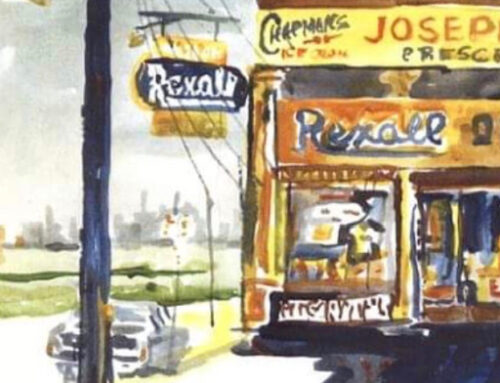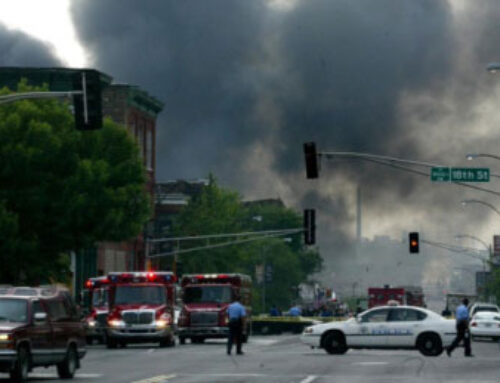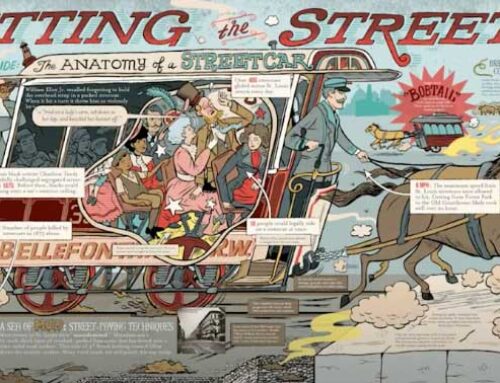Below is a subset from a well-researched history of street names for the City of St Louis. Every name tells a story, and ours in Lafayette Square are no exception. Please note our thanks at the bottom, as a lot of good work went into this compilation. ALBION PLACE (E-W). Platted in Funkhouser’s Lafayette Park Addition of 1875, Albion is the ancient, literary name for Great Britain. The name is drawn from a Celtic word meaning rock or mountain. (Lafayette Square) ARMSTRONG AVENUE (N-S). Apparently named for David H. Armstrong (1812-1893), a St. Louis postmaster and police commissioner who served as a U.S. Senator from Missouri 1877-1879 (he had been appointed to fill the seat vacated by the death of Lewis V. Bogy). (Lafayette Square) BENTON PLACE (N-S). An early private place laid out by Julius Pitzman in 1867. Named to honor Thomas Hart Benton, United States Senator from Missouri from 1821 to 1851. Benton supported legislation favoring Western development and expansion. (Lafayette Square) CARROLL STREET (E-W). Named by Julia C. Soulard to honor Daniel Carroll, brother of America’s first Roman Catholic bishop, John Carroll of Baltimore. (Soulard) CHOUTEAU AVENUE (E-W). Honors Auguste Chouteau, co-founder of St. Louis. As a l4 year old boy he supervised construction of the first buildings in the French colonial village of St. Louis. After American takeover in 1804, the section of this street west of Broadway was called “K” Street, with K being the twelfth letter of the alphabet for the twelfth street south of Market Street, the city’s north-south mid-line. When streets were given three names in 1826, the section of “K” from the wharf to Broadway was called Hazel. It was renamed Chouteau in 1857. (Downtown) (Lafayette Square) (Midtown) (Shaw) (Soulard) DOLMAN STREET (N-S). First laid out as a street in the subdivision of Lot 2 of the St. Louis Commons by Louis La Beaume and John Withnell in l845. It was named for John A. Dolman of the real estate firm of Dolman & Obear. (Soulard) EIGHTEENTH STREET (N-S). This street came into existence in the mid-1830s as Tayon Avenue, the spelled-as-pronounced name of Joseph Taillon, an original French settler who in 1765 built a dam to power the city’s first flour mill at the east end of Mill Creek Valley. In Old North St. Louis, it was Nineteenth Street from Washington to North Market Street until 1883. South of downtown, from Chouteau to Sidney Street, it was known as Second Carondelet Avenue until 1883. (Benton Park) (Downtown) (Lafayette Square) (Old North St. Louis-Yeatman) (Soulard) HICKORY STREET (E-W). Hickory originally served as the name for a street in the central business district, but that was renamed Wash Street in 1842. The next year, Hickory Street appeared on maps of the near south side. The name is taken from the hickory tree. (Lafayette Square) (Midtown) (Shaw) (Soulard) JEFFERSON AVENUE (N-S). A major street in Charles DeWard’s original 1836 plat of the St. Louis Commons, it honors Thomas Jefferson, third president of the United States, who authorized the Louisiana Purchase from France in 1803. (Benton Park) (Compton Hill) (Lafayette Square) (Marquette-Cherokee) (Midtown) (Old North St. Louis-Yeatman) KENNETT PLACE (E-W). Honors Luther M. Kennett, mayor of St. Louis from 1850 to 1852. It was platted in 1857 in the Stephen D. Barlow Addition (Barlow was an officer of the Iron Mountain Railroad). (Lafayette Square) LAFAYETTE AVENUE (E-W). So named in the original 1836 platting of the St. Louis Commons because it formed the southern boundary of Lafayette Park. It honors the Marquis de Lafayette (1757-1834), the French general and statesman who aided George Washington in the American Revolutionary War. He was enthusiastically received in St. Louis during a triumphal visit in 1825. (Compton Hill) (Lafayette Square) (Shaw) (Soulard)

LA SALLE STREET (E-W). Rene-Robert Cavalier Sieur de la Salle explored the Great Lakes and the Mississippi Valley for France, hoping to found a French empire in America. As part of these explorations, in 1682 he journeyed down the Mississippi past the site of St. Louis in 1682. Sections of the street in the Soulard area carried the names Labadie and Convent until 1881. La Salle was extended west of Grand in 1860, but not until 1881 were all segments along its line legislated to have the same name. (Lafayette Square) (Midtown) (Shaw) (Soulard) MACKAY PLACE (N-S). Named in l98l to honor James Mackay, who owned a large tract of land in the area about l800. Formerly Armstrong Avenue, named for Samuel G. Armstrong, (l839 l895), American educator, philanthropist and Union Army general in the Civil War. (Lafayette Square) MISSISSIPPI AVENUE (N-S). When the St. Louis Commons was platted in l836, the present area of Lafayette Park was reserved for public use. At that time, the two wide north and ¬south streets bounding the park were named for the two great rivers which meet near St. Louis. Mississippi Avenue, which bounds the park on the east, is named for the Father of Waters. In south St. Louis, the street name derives from the state of Mississippi (which is also named for the river). (Benton Park) (Lafayette Square) (Marquette-Cherokee) MISSOURI AVENUE (N-S). This avenue is named for the state of Missouri, which of course was named in turn for the Missouri River. The word “Missouri” is apparently an Indian word meaning “town of the big canoes”. (Lafayette Square) (Soulard) (Marine Villa) (Dutchtown North) NICHOLSON PLACE (N-S). Named for David Nicholson, a prominent St. Louis wine and grocery merchant, who built a fine home on the south side of Lafayette Avenue opposite the park in the l850s. (Lafayette Square) PARK AVENUE (E-W). Originated in the Lafayette Square neighbor-hood. It received its name in 1836 when Lafayette Park was set aside for public use in the division of the St. Louis Commons. PARK AVENUE (E-W) (continued) It borders the park on its north side. Its intersection with Thirty-ninth, in front of the former Bi-State Transit Administration Building, was the scene of a violent riot during a strike by the city’s street car workers in 1900. (Compton Hill) (Lafayette Square) (Midtown) (Shaw) (Soulard) PRESTON PLACE (N-S). Preston Place was platted in the Lafayette Addition of l859. It probably was named for the family of Francis Preston Blair, Jr. (l82l-l875), which owned land in the area. Francis, a Missouri political leader and a Union general in the Civil War, served as United States Senator from Missouri in l87l l873. His brother, Montgomery, was the owner and developer of Benton Place. (Lafayette Square) RUTGER LANE and STREET (E-W). Although the name was misspelled, this street was named for Arend Rutgers, an early German settler in St. Louis. His name appears on St. Louis street maps as early as 1842. (Lafayette Square) (Midtown) (Shaw) (Soulard) SIMPSON PLACE (N-S). Named for a partner in the iron manufacturing firm of Christopher and Simpson (William Simpson). He purchased the Bredell property in 1892 and sold the northeast corner of the tract to his brother in law, Jacob Christopher. After razing the old Bredell mansion, Simpson laid out a street across the tract and gave it his name. He then built a home on the northeast corner. His home closely matched Christopher’s house. (Lafayette Square) VAIL PLACE (N-S). Entrance to Newman and Howard’s Addition of 1859. Named for James H. Vail, the assistant circuit attorney in St. Louis in 1860. Socrates Newman was then the leading importer and dealer in gas lighting fixtures in St. Louis. He joined Richard J. Howard in developing this subdivision. (Lafayette Square) WAVERLY PLACE (N-S). The entrance to the estate of attorney Archibald Gamble, who erected a mansion at its south end in 1850. His daughter, Virginia, married Charles Gibson in 1851. The street was originally McNair Avenue, and later became Easton Place after Gamble’s widow, Louisa Easton Gamble. Archibald Gamble died in 1866. The family began calling the street Waverly Place in 1884 as a way of remembering Gamble’s favorite literature, the English Waverly novels. (Lafayette Square) WHITTEMORE PLACE (E-W). Named for Robert B. Whittemore, a wholesale hat and cap merchant, who was treasurer of the Mound City Mutual Building Association from 1869 to 1871. (Lafayette Square) Thanks to the St Louis Streets Index (1994), compiled by Dr. Glen Holt and Tom Pearson for the St Louis Public Library, and available in its entirety at Street Names Of St Louis Original source materials were researched and compiled by noted local author and historian, Norbury L Wayman.



